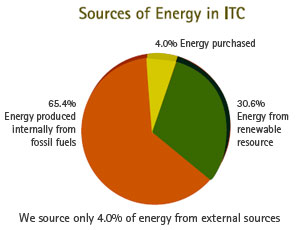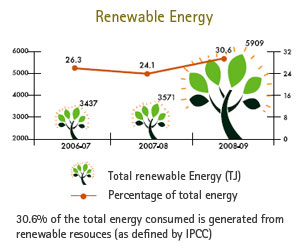STRATEGY 3 - MINIMISING ITC’S CARBON FOOTPRINT:
 ITC businesses continued to make concerted efforts in energy conservation and adopt renewable sources of energy to reduce the carbon intensity of ITC’s growing portfolio of products & services. ITC businesses continued to make concerted efforts in energy conservation and adopt renewable sources of energy to reduce the carbon intensity of ITC’s growing portfolio of products & services.
In 2008-09 significant growth in all ITC businesses together with the installation of the new pulp mill at Bhadrachalam (which has significantly reduced the import of pulp), commissioning of a new paper machine (thereby significantly enlarging the proportion of paper in the product mix - paper requiring almost 3 times the pulp needed to manufacture the same amount of paperboards) and a large number of project activities have resulted in total energy consumption of 19284 Terra Joules by ITC’s businesses (nearly 30% more than 14820 TJ in 07-08).
However, enhanced use of black liquor in the new pulp mill and installation of 9 grid connected wind power turbines to generate 14.1MW of electricity have helped us in containing CO2 emissions to within 16% over the previous year.
 Additional 4 wind power turbines (6 MW) and a ‘Green’ boiler (biomass-fired), now under installation will further reduce ITC’s GHG emissions from our Paperboards, Hotels and Packaging business. Additional 4 wind power turbines (6 MW) and a ‘Green’ boiler (biomass-fired), now under installation will further reduce ITC’s GHG emissions from our Paperboards, Hotels and Packaging business.
Our Cigarettes business, in 2008-09, reduced specific energy consumption from 5.97 to 5.77 GJ/million cigarettes (equivalent). Bengaluru, Kolkata and Saharanpur Cigarette factories achieved 9.2%, 2.4% and 2.1% savings in specific energy respectively – very significant achievements in units that are already very energy efficient. (British American Tobacco has reported specific energy consumption of 12.08 GJ/million cigarettes equivalent - Sustainability Report 2008. The Environment, Health & Safety Report, 2007 of Japan Tobacco International has reported specific energy consumption of 6.195 GJ/million cigarettes).
The other ITC units that have achieved significant reductions in specific energy consumption during the year include Surya Nepal’s Simra Cigarette unit (14.2%), Packaging & Printing unit at Munger (7.6%), Paper Mill at Tribeni (2.9%) ITC Hotel Maurya (6.3%), ITC Windsor (4.1%) and Sheraton Hotel Chola (6.1%).
|
• |
Black liquor waste from pulping process in Bhadrachalam Paperboards unit. |
| • |
Locally sourced chip/sawdust and de-oiled bran as boiler fuel in Kovai. |
| • |
Wind Energy farms for Packaging & Printing Business and ITC Hotel Kakatiya. |
| • |
Solar thermal systems for preheating boiler feed water and canteen hot water in a number of our units. |
|

